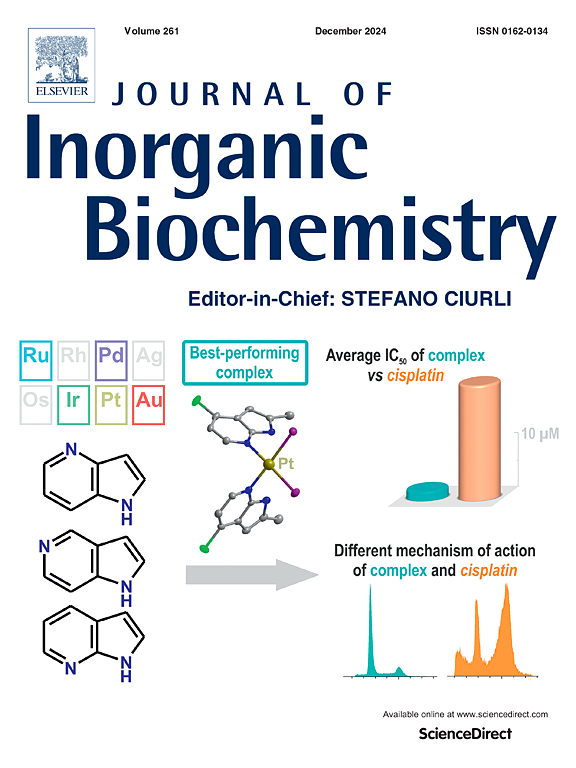Interaction of half-sandwich Rh(III) ion and some of its complexes with endogenous imidazole derivatives
IF 3.2
2区 化学
Q2 BIOCHEMISTRY & MOLECULAR BIOLOGY
引用次数: 0
Abstract
An increasing number of {Rh(η5-Cp*)}2+ complexes are reported to possess promising medical, mostly anticancer activities. In parallel, growing interest has also focused on the interactions between {Rh(η5-Cp*)}2+-based metallodrugs and macromolecular components of biological fluids, since the biospeciation of these potential metallodrugs may strongly influence their overall pharmacological properties. Less attention was paid to the interaction of {Rh(η5-Cp*)}2+ complexes with low molecular mass (LMM) constituents of biological fluids, which may also have significant impact on their biospeciation. From this point of view, the biogenic imidazole derivatives are the most important, since the primary binding sites of proteins for {Rh(η5-Cp*)}2+ cation are the surface histidine groups. Several imidazole containing endogenous LMM components are known, which have relevant concentrations in certain biological fluids, such as plasma. Therefore, here we report systematic solution thermodynamic and solution structural (potentiometric, UV–Vis, ESI-MS and 1H NMR) study on the interaction of {Rh(η5-Cp*)}2+ cation with thyrotropin-releasing hormone (TRH, pGlu-His-Pro-NH2, L1), carnosine (β-alanyl-histidine, L2), carcinine (β-alanyl-histamine, L3), histidine (L4) and the human growth modulator tripeptide GHK (Gly-His-Lys, L5). The results indicate, that these biogenic ligands, especially histidine and GHK, possess very high binding ability towards {Rh(η5-Cp*)}2+ cation, higher than for the well-known histidine-peptide binder copper(II). In addition, we also studied the interaction of two simple [Rh(η5-Cp*)(A)Cl]+ complexes (where A = 2,2′-bipyridyl (bpy) or ethylenediamine (en)), as mimics of potentially anticancer compounds, with the above listed endogenous imidazole derivatives. Beside the formation of ternary [Rh(η5-Cp*)(A)(L)] complexes, histidine and GHK, having exceptionally high {Rh(η5-Cp*)}2+ binding ability, are also able to displace en or bpy from the coordination sphere of Rh(III). Moreover, histidine and GHK successfully compete even with human serum albumin under near physiological conditions, and thus may have fundamental effect on the blood transport and biodistribution of any {Rh(η5-Cp*)}2+-based bioactive compounds.

半夹层Rh(III)离子及其配合物与内源性咪唑衍生物的相互作用
据报道,越来越多的{Rh(η5-Cp*)}2+复合物具有良好的医疗活性,主要是抗癌活性。与此同时,人们也越来越关注{Rh(η5-Cp*)}2+基金属药物与生物液体中大分子成分之间的相互作用,因为这些潜在金属药物的生物降解可能会极大地影响其整体药理特性。人们较少关注{Rh(η5-Cp*)}2+配合物与生物液体中低分子质量(LMM)成分的相互作用,因为这也可能对它们的生物降解产生重大影响。从这个角度来看,生物源咪唑衍生物最为重要,因为蛋白质与{Rh(η5-Cp*)}2+阳离子的主要结合位点是表面组氨酸基团。目前已知几种含咪唑的内源性 LMM 成分,它们在某些生物液体(如血浆)中具有相关浓度。因此,我们在此报告对{Rh(η5-Cp*)}2+阳离子与促甲状腺激素释放激素(TRH、pGlu-His-Pro-NH2,L1)、肌肽(β-丙氨酰-组氨酸,L2)、癌氨酸(β-丙氨酰-组胺,L3)、组氨酸(L4)和人类生长调节剂三肽 GHK(Gly-His-Lys,L5)的相互作用。结果表明,这些生物配体,尤其是组氨酸和 GHK,与{Rh(η5-Cp*)}2+阳离子的结合能力非常高,高于著名的组氨酸-肽结合剂铜(II)。此外,我们还研究了两种简单的[Rh(η5-Cp*)(A)Cl]+配合物(其中 A = 2,2′-联吡啶(bpy)或乙二胺(en))作为潜在抗癌化合物的模拟物与上述内源性咪唑衍生物的相互作用。除了形成三元[Rh(η5-Cp*)(A)(L)]配合物外,组氨酸和 GHK 还具有极高的{Rh(η5-Cp*)}2+结合能力,能够将 en 或 bpy 从 Rh(III) 的配位层中置换出来。此外,组氨酸和 GHK 甚至能在接近生理条件下成功地与人体血清白蛋白竞争,因此可能对任何基于{Rh(η5-Cp*)}2+的生物活性化合物的血液运输和生物分布产生根本性影响。
本文章由计算机程序翻译,如有差异,请以英文原文为准。
求助全文
约1分钟内获得全文
求助全文
来源期刊

Journal of Inorganic Biochemistry
生物-生化与分子生物学
CiteScore
7.00
自引率
10.30%
发文量
336
审稿时长
41 days
期刊介绍:
The Journal of Inorganic Biochemistry is an established international forum for research in all aspects of Biological Inorganic Chemistry. Original papers of a high scientific level are published in the form of Articles (full length papers), Short Communications, Focused Reviews and Bioinorganic Methods. Topics include: the chemistry, structure and function of metalloenzymes; the interaction of inorganic ions and molecules with proteins and nucleic acids; the synthesis and properties of coordination complexes of biological interest including both structural and functional model systems; the function of metal- containing systems in the regulation of gene expression; the role of metals in medicine; the application of spectroscopic methods to determine the structure of metallobiomolecules; the preparation and characterization of metal-based biomaterials; and related systems. The emphasis of the Journal is on the structure and mechanism of action of metallobiomolecules.
 求助内容:
求助内容: 应助结果提醒方式:
应助结果提醒方式:


